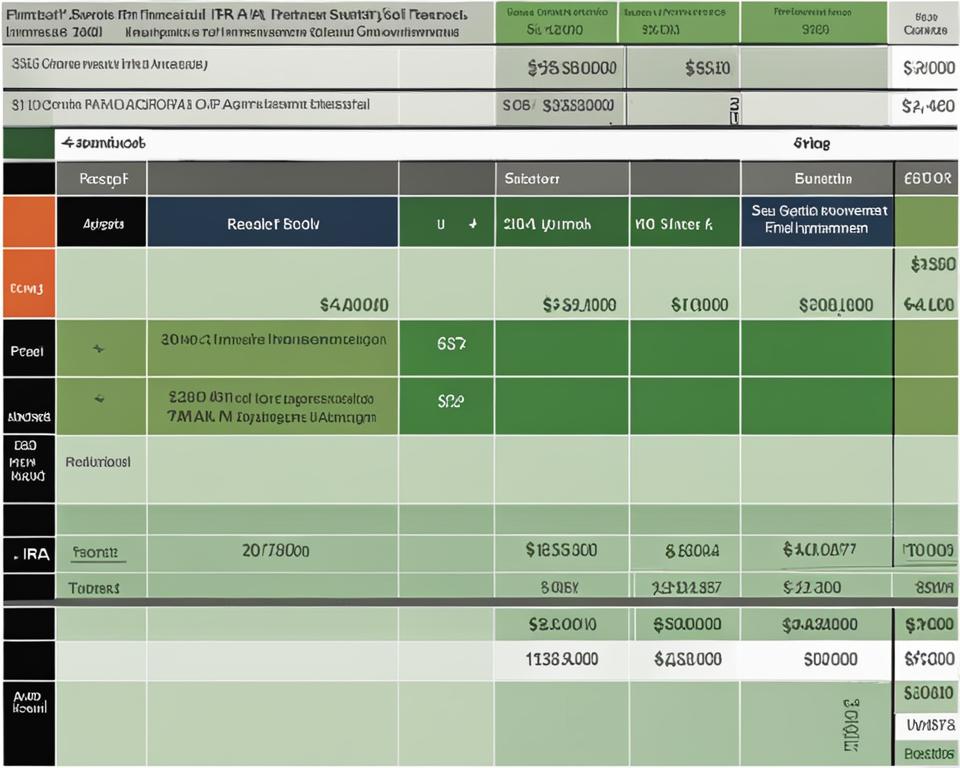When planning for your future and securing your retirement, it’s important to consider all available options. Fidelity Investments offers a range of IRA options with tailored fees and services to meet your specific needs. However, it’s essential to understand the risks involved in investing. The value of your investment will fluctuate over time, and there is a potential for both gains and losses.
Key Takeaways:
- Consider Fidelity Investments for your IRA needs
- Understand the risks and potential fluctuations in value
- Choose the right IRA account type based on your circumstances
- Be aware of the fees associated with your Fidelity IRA
- Research and compare different providers before making a decision
Choose the Right Fidelity IRA Account
When planning for your retirement with Fidelity Investments, it’s essential to choose the right IRA account that suits your individual needs. Fidelity offers various types of IRA accounts, including Traditional and Roth IRAs, each with distinct benefits and considerations.
Traditional IRAs:
Traditional IRAs allow you to contribute pre-tax income, providing current tax benefits. The funds in your Traditional IRA grow tax-deferred until withdrawal, typically during retirement. This type of account is ideal if you expect your tax rate to be lower at retirement or if you want to reduce your taxable income now. However, taxable income and early withdrawal penalties may apply when you start taking distributions from your Traditional IRA.
Roth IRAs:
Roth IRAs, on the other hand, offer tax-free distributions in retirement. You contribute after-tax income to a Roth IRA, which grows tax-free. When you make qualified withdrawals in retirement, you won’t owe taxes on the earnings. Roth IRAs are particularly beneficial if you expect your tax rate to be higher during retirement or if you want to maximize tax diversification in your retirement portfolio. It’s important to note that there are income limits for contributing to a Roth IRA, and early withdrawals may be subject to taxes and penalties.
Consulting a tax professional is crucial when deciding which IRA account type is most suitable for your financial situation and retirement goals. They can provide personalized guidance based on your income, tax bracket, and future plans.
| IRA Account Type | Tax Benefits | Withdrawal Taxes |
|---|---|---|
| Traditional IRA | Contributions are tax-deductible; Tax-deferred growth |
Taxed as ordinary income, Early withdrawal penalties may apply |
| Roth IRA | No upfront tax deduction; Tax-free growth |
No taxes on qualified withdrawals; Non-qualified withdrawals may be taxed and penalized |
Remember, your choice of IRA account will have long-term implications for your retirement savings. Take the time to assess your financial situation, consider your goals, and make an informed decision that aligns with your needs and objectives.
Understanding Fidelity IRA Fees
When it comes to managing your retirement savings, it’s crucial to have a clear understanding of the fees associated with your investment accounts. Fidelity Investments offers retail IRA accounts with no account fees or minimums to open, providing accessible options for individuals looking to secure their retirement.
However, it’s important to note that while there may be no account fees, there are expenses charged by investments and other potential transaction costs to consider. These fees can vary depending on the specific investments you choose for your IRA.
To ensure transparency and informed decision-making, Fidelity provides detailed information about fees on their website. By reviewing this information, you can gain a comprehensive understanding of the costs associated with your Fidelity IRA.
Fidelity IRA Fee Breakdown
| Fee Type | Description |
|---|---|
| Expense Ratios | These fees represent the percentage of assets deducted annually to cover the expenses of managing the investment funds within your IRA. |
| Transaction Costs | These fees may apply when buying or selling certain securities within your IRA, such as individual stocks or exchange-traded funds (ETFs). |
| Advisor Fees | If you choose to work with a financial advisor, they may charge fees for their services related to managing your Fidelity IRA. |
| Custodial Fees | Some IRAs may have custodial fees, which cover the administrative costs of maintaining your account. |
| Other Fees | Additional fees may apply depending on the specific investments, services, or features you choose for your Fidelity IRA. |
It’s essential to consider these fees and their potential impact on your investment returns. By understanding the costs involved, you can make informed decisions about your Fidelity IRA and optimize your retirement savings strategy.
Fidelity IRA Review
Fidelity Investments is a reputable and well-established financial institution that offers a wide range of investment options and retirement services. Many investors have found satisfaction in Fidelity’s IRA offerings, taking advantage of the diverse investment choices and robust retirement solutions provided.
When considering an IRA provider, it’s crucial to conduct thorough research and compare different companies to ensure you find the best fit for your individual needs. While Fidelity may be an excellent choice for many, it’s essential to evaluate other providers as well to make an informed decision.
“Fidelity Investments offers a wide range of investment options and retirement services that meet the needs of various investors. They have a reputation for providing excellent customer service and innovative tools to help you manage your retirement savings effectively.” – Financial Advisor, Jane Thompson

Fidelity’s commitment to helping investors achieve their retirement goals is reflected in their comprehensive range of investment options. Whether you’re looking for a Traditional IRA, Roth IRA, or a self-employed Solo 401(k), Fidelity has you covered.
The innovative tools and resources provided by Fidelity, such as their IRA calculator and online account management platform, make it easy to plan and track your retirement savings. Moreover, Fidelity’s customer service team is known for their expertise and dedication, providing guidance and support whenever needed.
Benefits of Fidelity IRA
- Wide range of investment options
- Flexible account types, including Traditional IRA, Roth IRA, and Solo 401(k)
- Innovative tools and resources for retirement planning
- Excellent customer service and support
In summary, Fidelity Investments is a leading provider of IRA accounts, offering a diverse range of investment options and retirement services. While many investors have found satisfaction with Fidelity, it’s always recommended to compare providers and evaluate their offerings to ensure you make the best choice for your retirement needs.
Fidelity IRA Rollover
If you have a retirement account with another provider, you can take advantage of Fidelity’s IRA rollover option. By consolidating your funds into an IRA with Fidelity, you gain more control over your investments and the potential for lower fees. It’s a convenient way to streamline your retirement savings and take advantage of Fidelity’s robust offerings.
Before initiating an IRA rollover, it’s crucial to consult with a financial advisor who can guide you through the process. They will help you understand the tax implications and eligibility requirements associated with the rollover.
“Consolidating retirement accounts through an IRA rollover can simplify your financial management and potentially enhance your investment opportunities.”
By consolidating your retirement accounts, you’ll have a clearer view of your overall portfolio and be better equipped to make informed investment decisions. Additionally, Fidelity’s seamless rollover process ensures that you can transfer your funds smoothly without disrupting your long-term financial goals.
To learn more about how to initiate a Fidelity IRA rollover and explore the benefits it can bring to your retirement strategy, visit the Fidelity website or contact their dedicated customer support team.
| Fidelity IRA Rollover Benefits | Additional Information |
|---|---|
| More control over investments | Personalize your retirement strategy |
| Potential for lower fees | Optimize your retirement savings |
| Streamline retirement accounts | Simplify financial management |
By taking advantage of Fidelity’s IRA rollover option, you can bring all your retirement accounts together and leverage Fidelity’s expertise in managing your investments. With a seamless transfer process and the potential to improve your retirement savings strategy, the Fidelity IRA rollover is worth considering for a secure and prosperous future.
Fidelity IRA Calculator
Planning for your retirement requires careful consideration of various factors, such as your age, income, and desired retirement goals. With Fidelity’s IRA calculator, you can easily determine how much you should contribute to your IRA to meet your specific needs.
The Fidelity IRA calculator takes into account your current savings, expected retirement age, desired income, and other relevant details to provide you with a personalized savings plan. By inputting these variables, the calculator generates an estimated contribution amount that aligns with your retirement objectives.
Using this tool allows you to make informed decisions about your retirement savings and helps you stay on track towards achieving your financial goals. Whether you’re just starting your retirement planning journey or looking to adjust your current contributions, the Fidelity IRA calculator can provide valuable insights to optimize your savings strategy.
Take advantage of this user-friendly tool and leverage Fidelity’s expertise to plan for a secure and prosperous retirement. Maximize your savings potential today with Fidelity’s IRA calculator.
| Key Features of Fidelity IRA Calculator | Benefits |
|---|---|
| Simplified planning | The calculator does the complex calculations for you, simplifying the process of determining your IRA contributions. |
| Personalized results | Receive customized contribution amounts based on your unique financial situation and retirement goals. |
| Realistic projections | Get a realistic estimate of the future value of your IRA based on your planned contributions. |
| Adjustable variables | Modify input values to explore different savings scenarios and see how they impact your retirement savings. |
| Flexible planning | Plan for different retirement age targets and income goals to ensure a comfortable retirement lifestyle. |
Fidelity Solo 401k vs IRA
If you’re a self-employed individual, Fidelity offers two retirement savings options that may suit your needs: Solo 401(k) plans and IRAs. Understanding the differences between these two retirement accounts can help you make an informed decision about which one is right for you.
Solo 401(k) Plans:
A Solo 401(k) plan is designed for business owners and their spouses, providing the opportunity to save for retirement while enjoying some tax benefits. Here are some key features of Solo 401(k) plans:
- Higher Contribution Limits: Solo 401(k) plans offer the potential for higher annual contribution limits compared to IRAs. As of 2021, you can contribute up to $58,000 ($64,500 if you’re age 50 or older) to your Solo 401(k) plan, which includes both employee and employer contributions.
- Tax Benefits: Contributions to a Solo 401(k) plan may be tax-deductible, reducing your taxable income for the year. Additionally, your earnings can grow tax-deferred until withdrawal.
- Borrowing Options: In certain circumstances, you may be able to borrow against your Solo 401(k) plan balance, providing access to funds if needed.
IRAs:
Individual Retirement Arrangements (IRAs) offer a wider range of options and flexibility compared to Solo 401(k) plans. Here’s what you need to know about IRAs:
- Greater Flexibility: IRAs allow you to choose from various investment options, such as stocks, bonds, mutual funds, and more. You have the freedom to manage and diversify your portfolio according to your risk tolerance and investment goals.
- Roth IRA Option: In addition to Traditional IRAs, Fidelity also offers Roth IRAs. With a Roth IRA, you contribute after-tax dollars, and qualified distributions in retirement are tax-free.
- No Requirement for Self-Employed Income: Unlike Solo 401(k) plans, IRAs don’t require you to have self-employed income to contribute. If you have other sources of income, you can still contribute to an IRA as long as you meet the IRS eligibility criteria.
Consider your specific circumstances and goals when choosing between a Solo 401(k) plan and an IRA. Consulting with a financial advisor can provide personalized guidance based on your needs. Ultimately, the right choice will depend on factors such as your income, contribution goals, and desired investment flexibility.
Quote:
“When deciding between a Fidelity Solo 401(k) plan and an IRA, it’s important to consider your long-term retirement goals, contribution limits, and investment preferences. Weigh the benefits of higher contribution limits and potential tax deductions with the flexibility and diverse investment options offered by IRAs.”
To help visualize the key differences between Solo 401(k) plans and IRAs, refer to the table below:
| Features | Solo 401(k) Plans | IRAs |
|---|---|---|
| Contribution Limits | Higher contribution limits, up to $58,000 ($64,500 if age 50 or older) annually | Lower annual contribution limits, up to $6,000 ($7,000 if age 50 or older) for Traditional and Roth IRAs |
| Tax Benefits | Potential tax deductions on contributions and tax-deferred growth | Tax advantages vary depending on account type (Traditional or Roth) |
| Investment Options | Relatively limited investment options offered by employers | Wide range of investment options, including stocks, bonds, and mutual funds |
| Borrowing Options | Potential to borrow against your Solo 401(k) balance | No borrowing options |

Fidelity IRA Login
Once you have opened an IRA account with Fidelity, accessing your account online is easy through the Fidelity website. Logging in provides you with convenient control over your retirement savings and investment management.
With the Fidelity IRA login, you can:
- Monitor your investments
- Make contributions
- Update your account information
- Review and adjust your investment strategy
Having online access to your Fidelity IRA account empowers you to stay informed about your retirement plan’s performance and take necessary actions to align with your goals. Whether you want to track your portfolio, make regular contributions, or explore new investment opportunities, the Fidelity IRA login offers convenient and secure access to manage your account effectively.
Ensure you have your login credentials ready to access your Fidelity IRA account on the Fidelity website.
Logging into your Fidelity IRA
- Visit the Fidelity Investments website.
- Click on the “Log In” button located at the top right corner of the page.
- Enter your username and password in the appropriate fields.
- Click “Log In” to access your Fidelity IRA account.
If you have forgotten your login credentials, you can retrieve or reset them using the available options on the Fidelity website.
Stay connected to your retirement savings with the Fidelity IRA login and take control of your financial future. Log in today and explore the tools and resources Fidelity offers to help you make informed decisions and maximize your retirement savings.
Fidelity Traditional IRA Withdrawal Rules
When it comes to withdrawing funds from a Traditional IRA, there are specific rules and conditions that need to be met. Generally, distributions before age 59½ are subject to a penalty, unless certain exceptions such as disability or qualified first-time home purchase apply. It’s important to consult IRS guidelines and seek advice from a tax professional to fully understand the rules and implications of Traditional IRA withdrawals.
Penalty for Early Withdrawal
If you withdraw funds from your Traditional IRA before reaching the age of 59½, you may be subject to a penalty. The penalty is usually 10% of the amount withdrawn and is in addition to any applicable income tax. However, there are a few exceptions that allow for penalty-free withdrawals.
- The first exception is disability. If you become disabled, you may be eligible to take early distributions from your Traditional IRA without incurring the penalty.
- Another exception is a qualified first-time home purchase. You may withdraw up to $10,000 from your Traditional IRA to cover certain expenses related to buying your first home without penalty.
It’s important to note that while these exceptions allow for penalty-free withdrawals, the withdrawn amount may still be subject to income tax. It’s crucial to consult with a tax professional to understand the tax implications specific to your situation.
Required Minimum Distributions (RMDs)
Once you reach the age of 72, you are generally required to take minimum distributions from your Traditional IRA each year. The amount you must withdraw is based on the balance of your IRA and your life expectancy. Failing to take the required minimum distribution can result in substantial penalties.
Consult IRS Guidelines and a Tax Professional
“Understanding the rules and regulations surrounding Traditional IRA withdrawals is crucial to avoid penalties and make informed decisions about your retirement savings.”
Withdrawals from a Traditional IRA involve complex rules and tax implications. It’s highly recommended to consult the official IRS guidelines and consider seeking advice from a qualified tax professional. They can provide personalized guidance based on your individual circumstances and ensure compliance with all applicable regulations.
| Age | Penalty-Free Withdrawals |
|---|---|
| 59½ or older | No penalty for withdrawals |
| Before 59½ | Penalty applies, unless for disability or qualified first-time home purchase |
Fidelity Roth IRA Withdrawal Rules
Roth IRAs offer tax-free distributions in retirement, provided certain conditions are met. To fully benefit from a Fidelity Roth IRA, it’s important to understand and adhere to the withdrawal rules.
Distributions from a Fidelity Roth IRA must be qualified, meaning that the account has been open for at least five years and specific criteria are met. These criteria include:
- Reaching the age of 59½ or older
- Experiencing a disability
- Making a qualified first-time home purchase
- Passing away, with the distributions going to beneficiaries
It’s essential to understand that a Roth IRA withdrawal must meet these conditions to be considered tax-free. Failure to meet these criteria may result in taxes and potential penalties.
Speak with a financial advisor or consult Fidelity’s resources to gain a complete understanding of the withdrawal rules for a Fidelity Roth IRA, ensuring that you can maximize the benefits of your retirement savings.
Takeaway
Adhering to the Roth IRA withdrawal rules is crucial in making the most of your Fidelity Roth IRA. By understanding the conditions that qualify for tax-free distributions and seeking advice from professionals, you can enjoy the benefits of your retirement savings without incurring unnecessary taxes or penalties.
| Qualified Criteria | Description |
|---|---|
| Age 59½ or older | Individuals who have reached the age of 59½ or older are eligible for tax-free distributions. |
| Disability | Participants who experience a disability can access their funds tax-free. |
| Qualified first-time home purchase | Roth IRA funds can be withdrawn tax-free for the purchase of a first home. |
| Death | In the unfortunate event of the account owner’s passing, the beneficiaries can access the funds tax-free. |
Maximize Your Fidelity IRA With Fidelity Freedom Funds
When it comes to maximizing your Fidelity Investments IRA, Fidelity Freedom Funds can be a valuable option to consider. These target-date funds are specifically designed for investors who have a target retirement year in mind. As the target date approaches, the asset allocation of the funds gradually shifts towards a more conservative strategy, reducing the level of risk.
| Fidelity Freedom Fund | Target Year | Asset Allocation |
|---|---|---|
| Fidelity Freedom Fund 2025 | 2025 | 60% stocks, 40% bonds |
| Fidelity Freedom Fund 2030 | 2030 | 55% stocks, 45% bonds |
| Fidelity Freedom Fund 2035 | 2035 | 50% stocks, 50% bonds |
By investing in Fidelity Freedom Funds, you can simplify the management of your Fidelity IRA and benefit from a professionally managed portfolio that aligns with your retirement goals. These funds provide diversification across various asset classes, allowing you to tap into the potential growth of stocks while also providing stability through bonds. The asset allocation adjustments made by the funds over time help to preserve capital as you near retirement.
It is important to note that Fidelity Freedom Funds are not the only investment options available for your Fidelity IRA. It’s essential to consider your risk tolerance, investment objectives, and time horizon before making any investment decisions. Consulting with a financial advisor can help you determine the right mix of investments to maximize your Fidelity IRA’s potential for growth while managing risk effectively.
Conclusion
In conclusion, Fidelity Investments offers a diverse range of IRA options to help you secure your retirement. With careful consideration of account fees, investment choices, and tax implications, you can choose the right IRA account that aligns with your financial goals and circumstances.
Utilizing Fidelity’s user-friendly online tools, such as the IRA calculator, can empower you to make well-informed decisions when planning your retirement savings. These resources provide valuable insights into contribution amounts, potential growth, and investment strategies tailored to your specific needs.
However, it is crucial to remember that no matter the investment vehicle or provider you choose, consulting with a qualified financial advisor is essential. They can provide personalized guidance and ensure that your retirement planning approach efficiently maximizes the benefits of a Fidelity IRA account.
FAQ
What IRA options does Fidelity Investments offer?
Fidelity Investments offers both Traditional and Roth IRAs, allowing you to choose the account type that aligns with your retirement goals and tax preferences.
Are there any fees or minimums to open an IRA account with Fidelity?
Fidelity retail IRA accounts have no account fees or minimums to open. However, it’s important to consider expenses charged by investments and other potential transaction costs.
Is Fidelity a trusted provider for IRAs?
Fidelity is a well-established and trusted financial institution with a range of investment options and retirement services. Many investors are satisfied with Fidelity’s IRA offerings, but it’s always recommended to research and compare different providers.
Can I rollover my retirement account into a Fidelity IRA?
Yes, Fidelity allows you to rollover your funds from another provider into an IRA with them, providing you with more control over your investments and potentially lower fees. Consult with a financial advisor to understand any tax implications or eligibility requirements.
How can I determine how much to contribute to my Fidelity IRA?
Fidelity offers an IRA calculator that can help you determine the appropriate contribution amount based on your age, income, and retirement goals. This tool can assist you in making informed decisions about your retirement savings.
What are the differences between a Fidelity Solo 401(k) plan and an IRA?
While a Solo 401(k) plan offers higher contribution limits, IRAs provide greater flexibility and a wider range of investment options. Consider your specific needs and consult with a financial advisor to decide which option is best for you.
How do I access my Fidelity IRA account online?
Once you have opened an IRA account with Fidelity, you can easily access your account online through the Fidelity website. Logging in allows you to monitor your investments, make contributions, and manage your retirement savings efficiently.
What are the rules for withdrawing funds from a Traditional IRA?
When it comes to withdrawing funds from a Traditional IRA, there are specific rules and conditions that need to be met. Generally, distributions before age 59½ are subject to a penalty, unless certain exceptions such as disability or a qualified first-time home purchase apply. Consult IRS guidelines and a tax professional for understanding the rules and implications.
What are the rules for withdrawing funds from a Roth IRA?
Roth IRAs offer tax-free distributions in retirement, provided certain conditions are met. Distributions must be qualified, meaning that the account has been open for at least five years and certain criteria are met, such as age 59½ or older, disability, a qualified first-time home purchase, or death. It’s important to understand and adhere to these rules to fully benefit from a Roth IRA.
What are Fidelity Freedom Funds and how can they maximize my Fidelity IRA?
Fidelity Freedom Funds are a range of target-date funds designed for investors who plan to retire around a specific target year. These funds gradually shift towards a more conservative asset allocation as the target date approaches. Consider Fidelity Freedom Funds as a potential option to simplify your retirement planning and maximize your Fidelity IRA.




